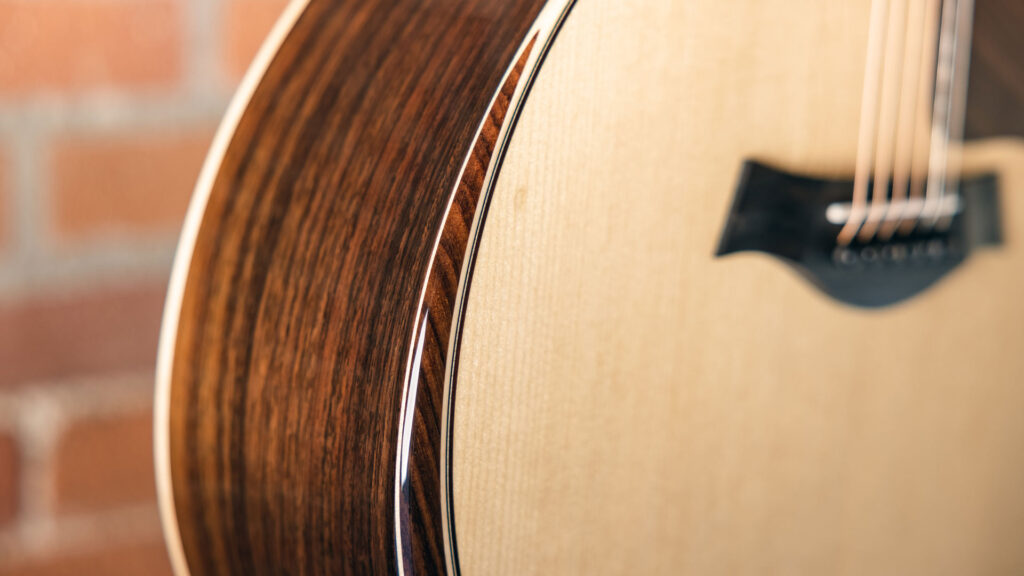Along with body shape and top woods, the woods used for the back and sides of an acoustic guitar play a key role in coloring the guitar’s voice. Hardwoods, such as rosewood, mahogany, koa and maple, are exclusively used. They provide the supportive shell of the guitar body, and their hardness and density add the rigidity that helps generate sustain from the notes.
Each hardwood species has its own distinctive blend of physical properties, such as grain structure, density, weight and strength, which contribute to a guitar’s final tonal output.
To help players better compare and differentiate the sonic profile of each hardwood species we use on our guitars, Taylor’s head luthier, Andy Powers, has highlighted four categories that directly relate to the playing experience: frequency range, overtone profile, reflectivity and touch sensitivity. Note that the back and side woods are merely one part of a larger system of interacting parts, plus the design recipe of the builder. Ultimately, these characteristics can help people understand how a particular wood might sound in a guitar, but every guitar will sound a bit different in every player’s hands.
We’ll use one of our favorite tonewoods, Indian rosewood, as an example of each characteristic.

Trait 1: Frequency Range
Think of frequency range as a kind of EQ of the guitar’s sonic character. Every guitar produces frequencies ranging from low to high, and when you strum a guitar or pluck a single note, you’re hearing not just one pitch but many blended into a whole. Different woods contribute more low frequencies than others, just as some woods will deliver more focus in the middle or high end of the spectrum.
Frequency Range of Indian Rosewood
One of the classic acoustic guitar body woods, Indian rosewood is beloved for its unique frequency profile that delivers a strong response in both the lowest and highest ends of the tonal spectrum, with a slight “scoop” in the midrange (meaning you’re hearing less of the midrange than the bass and treble). The result is a response with clear, crisp high frequencies and warm bass tones.
Trait 2: Overtone Profile
Overtones represent the “hidden sounds” of a guitar and are defined by the harmonic series present in each string. In physics terms, overtones originate from the first octave, the next fifth, the next octave from the previous one, and so on. These tones are not actually separate from the note being played (the “fundamental”), but they can add depth and texture in the context of a guitar’s sound. Some players enjoy overtones and the feeling of richness they bring; others prefer a more “focused” sound where the fundamental note is the primary sound heard, opting for a “cleaner” tone, especially in situations where other instruments are also in the mix. Other terms to describe the degree of overtones include “wet,” referring to an overtone-heavy response, and “dry,” referring to a fundamental-strong response.
Overtone Profile of Indian Rosewood
One of the many reasons why luthiers have used rosewood for guitar backs and sides is its lush overtone profile, one that’s rich with harmonic texture and depth, especially in the high and low end. As a guitar built with Indian rosewood sustains out, you’ll hear the overtones bloom and resonate around the fundamental note. By comparison, mahogany tends to be thought of as a dry-sounding wood with a limited overtone profile and a strong focus on the fundamental note.
Trait 3: Reflectivity
This refers to how strongly a wood’s natural sonic characteristics are reflected in a guitar’s voice compared to the player (or guitar designer). Some body woods are highly distinctive in their sound, producing a signature profile that comes across clearly even when a guitar is played in different ways by different players. Other woods tend to play a more neutral or transparent role, allowing the guitar to channel the player’s touch or technique or the builder’s design.
Reflectivity of Indian Rosewood
Rosewood is recognized as a highly wood-reflective material for guitar backs and sides. Its treble- and bass-range focus and scooped midrange will persist with different players, as will its active overtone profile. By contrast, maple, mahogany and our Urban Ash tonewoods are highly player-reflective, taking on a fresh voice with each new set of hands.
Trait 4: Touch Sensitivity
Of the four characteristics we’re using to describe how body woods affect tone, touch sensitivity may be the most self-explanatory. It simply describes how easily a wood is set in motion with the vibration from the guitar’s strings. A highly touch-sensitive wood will respond to a very light touch with an open, responsive quality, delivering immediate sound without the need for a heavy attack. Woods that are less touch sensitive will respond well to a more aggressive attack, serving up projection and volume when the player really digs into the guitar.
Touch Sensitivity of Indian Rosewood
Indian rosewood is among the denser of the body woods frequently used for acoustic guitar backs and sides, which is partially responsible for its low touch sensitivity. You’ll hear more clarity and definition with a rosewood guitar when you play it with a heavier picking or strumming technique. (Keep in mind, though, that the top wood used will also contribute to the touch sensitivity.) Mahogany, meanwhile, is somewhat less dense and hard than rosewood, and as a result, it’s easier to set in motion with a light touch. Mahogany remains very clear and crisp at low volumes, a trait valued by players in studio settings.
More about tonewoods and sound
Want to learn more about how tonewoods define a guitar’s sound? Read up on hardwood and softwood tops elsewhere on the Taylor blog.

























